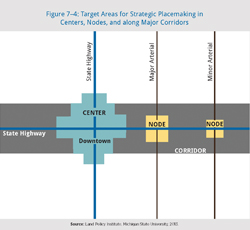Five essential community commitments to walkable places
There are five essential commitments that communities must make toward walkable places, which are taken from the Land Policy Institute’s guidebook on Placemaking as an Economic Development Tool.

Effective placemaking is built around walkable places. While much can be done to activate public spaces in places with good urban form, it is hard to sustain if the community does not have a lot of people living there or a convenient way to get them there. There are five essential commitments that communities must make toward walkable places, which are taken from the Land Policy Institute’s guidebook on Placemaking as an Economic Development Tool. They are all essential to creating quality places where people want to live, work, play, shop, learn and visit. Without them, any amount of placemaking will result in underperformance or less-than-desired outcomes.
Places that have these five components are much easier to engage in placemaking, which can effectively activate a public space. Some of these commitments require planning, investments or regulations, and in some cases, all of the above.
 The first commitment says the community must put people ahead of cars, meaning that places at key nodes and along key corridors should feature a complete and safe sidewalk system that promotes a pedestrian and bike-friendly environment. Secondly, residential density must be increased in downtowns at key nodes and along key corridors, so that people can meet daily needs and walk to necessary places from their homes. Third, mixed uses must be allowed in downtowns at these key nodes and corridors as well. Mixed uses include spaces that have retail and personal service uses on the first floor (and sometimes the second), with the second and third floors being occupied by residential uses in a three-story building. If the building is larger than four stories, more floors can be allocated for office uses. Mixed use also can mean that there is no on-site vehicle parking requirement, and that the residential units are mixed income. The fourth essential commitment involves emphasizing building form over use when it comes to regulation. With the exception of very small villages, it is necessary to prohibit one-story buildings downtown, at key nodes and possibly even along key corridors. In these areas there should also be no parking in front of the buildings (beyond curbside or angled parking), and downtown buildings should not be set back from the front building line or sideyard line. Finally, the last commitment states that as soon as it is feasible, an urban community with a compact form should have fixed-route transit that provides service from the downtown to key locations.
The first commitment says the community must put people ahead of cars, meaning that places at key nodes and along key corridors should feature a complete and safe sidewalk system that promotes a pedestrian and bike-friendly environment. Secondly, residential density must be increased in downtowns at key nodes and along key corridors, so that people can meet daily needs and walk to necessary places from their homes. Third, mixed uses must be allowed in downtowns at these key nodes and corridors as well. Mixed uses include spaces that have retail and personal service uses on the first floor (and sometimes the second), with the second and third floors being occupied by residential uses in a three-story building. If the building is larger than four stories, more floors can be allocated for office uses. Mixed use also can mean that there is no on-site vehicle parking requirement, and that the residential units are mixed income. The fourth essential commitment involves emphasizing building form over use when it comes to regulation. With the exception of very small villages, it is necessary to prohibit one-story buildings downtown, at key nodes and possibly even along key corridors. In these areas there should also be no parking in front of the buildings (beyond curbside or angled parking), and downtown buildings should not be set back from the front building line or sideyard line. Finally, the last commitment states that as soon as it is feasible, an urban community with a compact form should have fixed-route transit that provides service from the downtown to key locations.
To fully maximize the potential of placemaking projects and activities in your community, try adhering to these key commitments for walkable places. This will ensure a strong focus on creating public spaces that are safe, inviting, and engaging for local residents and visitors.
To learn more, order your free copy of the Placemaking Guidebook today.



 Print
Print Email
Email